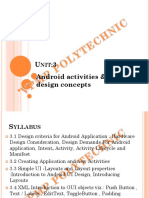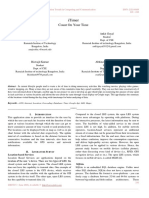0 ratings0% found this document useful (0 votes)
12 views9 Android List and Maps
9 Android List and Maps
Uploaded by
Marichris VenturaThis document discusses Android lists, maps, and location features. It describes the different types of Android lists like ListView, RecyclerView, GridView, and ExpandableListView. It explains how to create basic lists using ListView, CustomView, and RecyclerView. It also covers Android location and maps APIs, using GPS to find the current location, and integrating Google Maps into Android apps.
Copyright:
© All Rights Reserved
Available Formats
Download as PPTX, PDF, TXT or read online from Scribd
9 Android List and Maps
9 Android List and Maps
Uploaded by
Marichris Ventura0 ratings0% found this document useful (0 votes)
12 views13 pagesThis document discusses Android lists, maps, and location features. It describes the different types of Android lists like ListView, RecyclerView, GridView, and ExpandableListView. It explains how to create basic lists using ListView, CustomView, and RecyclerView. It also covers Android location and maps APIs, using GPS to find the current location, and integrating Google Maps into Android apps.
Original Title
9-Android-List-and-Maps
Copyright
© © All Rights Reserved
Available Formats
PPTX, PDF, TXT or read online from Scribd
Share this document
Did you find this document useful?
Is this content inappropriate?
This document discusses Android lists, maps, and location features. It describes the different types of Android lists like ListView, RecyclerView, GridView, and ExpandableListView. It explains how to create basic lists using ListView, CustomView, and RecyclerView. It also covers Android location and maps APIs, using GPS to find the current location, and integrating Google Maps into Android apps.
Copyright:
© All Rights Reserved
Available Formats
Download as PPTX, PDF, TXT or read online from Scribd
Download as pptx, pdf, or txt
0 ratings0% found this document useful (0 votes)
12 views13 pages9 Android List and Maps
9 Android List and Maps
Uploaded by
Marichris VenturaThis document discusses Android lists, maps, and location features. It describes the different types of Android lists like ListView, RecyclerView, GridView, and ExpandableListView. It explains how to create basic lists using ListView, CustomView, and RecyclerView. It also covers Android location and maps APIs, using GPS to find the current location, and integrating Google Maps into Android apps.
Copyright:
© All Rights Reserved
Available Formats
Download as PPTX, PDF, TXT or read online from Scribd
Download as pptx, pdf, or txt
You are on page 1of 13
ANDROID LIST,
LOCATION AND MAPS
ANDROID LISTS
Unlike sets, lists typically allow duplicate
elements. More formally, lists typically allow pairs
of elements e1 and e2 such that e1.equals(e2), and
they typically allow multiple null elements if they
allow null elements at all. It is not inconceivable
that someone might wish to implement a list that
prohibits duplicates, by throwing runtime
exceptions when the user attempts to insert them,
but we expect this usage to be rare.
TYPES OF ANDROID LISTS
• ListView: This is one of the oldest list views in Android.
It's a vertically scrolling list that can display a large
number of items. It's straightforward to use, but it's not
very flexible.
• RecyclerView: This is the successor to the ListView. It's
more flexible and powerful than the ListView and allows
you to implement complex layouts and animations. It's
recommended to use RecyclerView for new projects.
TYPES OF ANDROID LISTS
• GridView: This is a two-dimensional scrolling
list that displays items in a grid. It's useful for
displaying images or other items that need to be
organized in a grid.
• Spinner: This is a dropdown list that allows the
user to select one item from a list of options. It's
commonly used in forms or settings screens.
TYPES OF ANDROID LISTS
• Expandable ListView: This is a ListView that
can display a list of groups and their child items.
It's useful for displaying hierarchical data, such
as a list of categories and their subcategories.
• RecyclerView with GridLayout: This is
similar to the GridView, but it uses the
RecyclerView to display a grid of items. It's
more flexible than the GridView and allows you
to implement complex layouts and animations.
CREATING ANDROID LIST
To create a list in Android, you can use either a ListView or a RecyclerView. Visit the
given links create a basic list using a ListView, CustomView and Recycler View List:
https://www.javatpoint.com/android-listview-example
Using Custom View
https://www.javatpoint.com/android-custom-listview
Using Recyler View
https://www.javatpoint.com/android-recyclerview-list-example
ANDROID LOCATION AND MAPS
• Android Location and Maps refer to the set of features and tools provided by the
Android operating system for developers to create location-aware applications.
Android provides various classes and interfaces to access the device's GPS, network
location, and other sensors to determine the device's location.
ANDROID LOCATION AND MAPS
• The Android Maps API allows developers to integrate Google Maps into their
applications, display maps, and use the Maps API to display various features such as
markers, polylines, and polygons on the map. With the Maps API, developers can add
location-based features such as search, routing, and location tracking to their apps.
ANDROID LOCATION AND MAPS
• Overall, Android Location and Maps provide a powerful set of tools for developers to
create location-based applications, and they are widely used in many types of apps,
including navigation, weather, fitness, and social media.
ANDROID GOOGLE MAPS
• Android Google Maps is a service provided by Google that allows developers to
integrate maps and location-based services into their Android applications. With the
Google Maps API for Android, developers can add a variety of features to their apps,
such as displaying maps, adding markers and overlays, providing directions, and
displaying user location.
USING GPS TO FIND CURRENT LOCATION IN
ANDROID
• Using GPS to find the current location in an Android app refers to the process of
accessing the GPS (Global Positioning System) module of an Android device to
determine the device's current latitude and longitude coordinates. The GPS module
uses signals from GPS satellites to determine the device's location accurately.
USING GPS TO FIND CURRENT LOCATION IN
ANDROID
• To use GPS to find the current location in an Android app, you need to request the
user's location permission, create a LocationManager object, and request location
updates. Then, you can implement a LocationListener to receive updates and get the
current location in the onLocationChanged() method of the listener.
USING GPS TO FIND CURRENT LOCATION IN
ANDROID
• You can use the latitude and longitude coordinates of
the current location to perform various location-based
actions in your app, such as displaying the user's
location on a map, providing directions, or searching
for nearby places.
• https://www.javatpoint.com/android-google-map
• https://
www.javatpoint.com/android-google-map-displaying-c
urrent-location
• https://
You might also like
- Lay OutDocument18 pagesLay OutgiratheayushNo ratings yet
- Week 1 Android Programming What Is Android?Document47 pagesWeek 1 Android Programming What Is Android?nino sulitNo ratings yet
- Reflection Notes: - BootstrapDocument5 pagesReflection Notes: - BootstrapSwathi ShiragaddiNo ratings yet
- Android: 1.2. Forward and Reverse GeocodingDocument2 pagesAndroid: 1.2. Forward and Reverse GeocodingYuva RajNo ratings yet
- Final PPTDocument32 pagesFinal PPTShailendra RajputNo ratings yet
- Android AdapterDocument45 pagesAndroid Adaptershijinbgopal0% (1)
- Assignment 3 Group B Graphics PrimitiveDocument11 pagesAssignment 3 Group B Graphics Primitivebeprojectwork2025No ratings yet
- List View Ne Programim MobileDocument17 pagesList View Ne Programim MobileSaiDj DulevicNo ratings yet
- MAD Ch-4Document44 pagesMAD Ch-4Mann VoraNo ratings yet
- Ap Unit-2Document29 pagesAp Unit-2storianmarketingNo ratings yet
- UntitledDocument11 pagesUntitledAryan LadNo ratings yet
- U:3 Android Activities & GUI Design ConceptsDocument32 pagesU:3 Android Activities & GUI Design ConceptsAnchal SinghNo ratings yet
- ITE 2152 Introduction To Mobile Application Development: Week 11Document23 pagesITE 2152 Introduction To Mobile Application Development: Week 11lakmini gunarathnaNo ratings yet
- W1 Lec01 Lec02 LayoutsDocument25 pagesW1 Lec01 Lec02 LayoutsAyesha AliNo ratings yet
- ch4 1Document16 pagesch4 1Ved SawantNo ratings yet
- L02 - Android Layout (ITP4501) 2020Document56 pagesL02 - Android Layout (ITP4501) 2020Steven King (Asterisk)No ratings yet
- SeminarDocument25 pagesSeminarVISHAL BHOJWANINo ratings yet
- Mada Unit2Document6 pagesMada Unit2chaudharirohan864No ratings yet
- Android M-3Document14 pagesAndroid M-3abhiramtp71No ratings yet
- Mad Chapter 3 Cm6iDocument68 pagesMad Chapter 3 Cm6isaisinare19No ratings yet
- Mad 2Document13 pagesMad 2Rohit KatreNo ratings yet
- Mad Note02Document37 pagesMad Note02Divya RahaneNo ratings yet
- Mad Note02Document27 pagesMad Note02Saloni PatilNo ratings yet
- Practical No 14Document14 pagesPractical No 14Danish AliNo ratings yet
- Project On: Park This - Park Anywhere (Android App)Document32 pagesProject On: Park This - Park Anywhere (Android App)Shakil Jamil AkhtarNo ratings yet
- Part A: 2020 MarchDocument9 pagesPart A: 2020 Marchnarutouzumakiyt00No ratings yet
- Itimer: Count On Your TimeDocument4 pagesItimer: Count On Your Timerahul sharmaNo ratings yet
- Android XML Layouts - A Study of Viewgroups and Views For UI Design in Android ApplicationDocument17 pagesAndroid XML Layouts - A Study of Viewgroups and Views For UI Design in Android ApplicationNajmi khan KhanNo ratings yet
- Layouts in Android StudioDocument10 pagesLayouts in Android StudioMahMal FAtima0% (1)
- Desarrollo Practico Con AndroidDocument227 pagesDesarrollo Practico Con Androider_ceaNo ratings yet
- Understanding The Components of A ScreenDocument5 pagesUnderstanding The Components of A ScreenRushda Shaik100% (2)
- Mad Unit2Document101 pagesMad Unit2Lakshmi M100% (1)
- Augmented RealityDocument57 pagesAugmented RealityNajeeb KhanNo ratings yet
- Prerequisite: One Must Know "How To Code A Custom List View"?Document11 pagesPrerequisite: One Must Know "How To Code A Custom List View"?thinke12boyNo ratings yet
- AndroidDocument2 pagesAndroidsurajsc2003No ratings yet
- Shopping Buddy: Cellular Networks and Mobile Computing COMS E6998 Final Project ReportDocument9 pagesShopping Buddy: Cellular Networks and Mobile Computing COMS E6998 Final Project ReportzakeermasNo ratings yet
- LocationDocument10 pagesLocationjunkBOX GladiAtorNo ratings yet
- Mad QB CT - 1 (2023-24)Document11 pagesMad QB CT - 1 (2023-24)connect.goldlabsNo ratings yet
- MAD LectureNotesDocument49 pagesMAD LectureNotesdp10012003No ratings yet
- Chapter 5Document84 pagesChapter 5Chavan KamleshNo ratings yet
- Android LayoutsDocument17 pagesAndroid Layoutskailashtrade27No ratings yet
- Android SDK FeaturesDocument20 pagesAndroid SDK Featuresgauravrokade762No ratings yet
- Android (HandOut)Document7 pagesAndroid (HandOut)MegaVNo ratings yet
- Android Chapter04 User InterfacesDocument104 pagesAndroid Chapter04 User InterfacesTrần Văn ThànhNo ratings yet
- Research On Mobile Location Service Design Based On AndroidDocument27 pagesResearch On Mobile Location Service Design Based On AndroidManoj VermaNo ratings yet
- Unit 3 Android Basic GUIDocument36 pagesUnit 3 Android Basic GUIabebemako302No ratings yet
- Notes MADDocument68 pagesNotes MADakashsaravanan790No ratings yet
- MAD Chapter 4Document61 pagesMAD Chapter 4Shaikh WasimaNo ratings yet
- Mobile Applications Lecture 3 - User Interface (I)Document24 pagesMobile Applications Lecture 3 - User Interface (I)Omar MagdyNo ratings yet
- Android Fragments and Layouts NotesDocument64 pagesAndroid Fragments and Layouts NotesChandana InguvaNo ratings yet
- Anatomy of Android ApplicationDocument6 pagesAnatomy of Android Applicationsibusisobheka198No ratings yet
- Android TutorialDocument15 pagesAndroid TutorialAditi KokaneNo ratings yet
- Mad Unit Ii-1Document97 pagesMad Unit Ii-1fathimaashna566No ratings yet
- UNIT-3 Android User InterfaceDocument49 pagesUNIT-3 Android User InterfaceAbhay PawarNo ratings yet
- Unit6 AndroidDocument4 pagesUnit6 AndroiddeepuhumneNo ratings yet
- Location Awareness PGDocument91 pagesLocation Awareness PGturkitoNo ratings yet
- Question Bank MAD PT2 Exam 22-23-CO-IFDocument24 pagesQuestion Bank MAD PT2 Exam 22-23-CO-IFatharvbowlekarNo ratings yet
- Module 12 15Document19 pagesModule 12 15centenotrixianajoyNo ratings yet
- Build Location Apps on iOS with Swift: Use Apple Maps, Google Maps, and Mapbox to Code Location Aware Mobile AppsFrom EverandBuild Location Apps on iOS with Swift: Use Apple Maps, Google Maps, and Mapbox to Code Location Aware Mobile AppsNo ratings yet
- Writing A For and Against Essay: Some Tips and SuggestionsDocument15 pagesWriting A For and Against Essay: Some Tips and SuggestionsJulia100% (1)
- CSR Lecture 2 ISHDocument18 pagesCSR Lecture 2 ISHseemakatariaNo ratings yet
- KA 2020 2 Redox-PotentiometryDocument55 pagesKA 2020 2 Redox-PotentiometryNicolaus DedeoNo ratings yet
- State Exam Preparation-2Document55 pagesState Exam Preparation-2julyyamNo ratings yet
- Volume 1 Tender & Contract ConditionsDocument104 pagesVolume 1 Tender & Contract ConditionsShakeelKhanNo ratings yet
- College of Engineering Electrical & Electronic Department Design of An Electrical Power Systems Equipment's Lec 2 Design H.V Transmission LinesDocument42 pagesCollege of Engineering Electrical & Electronic Department Design of An Electrical Power Systems Equipment's Lec 2 Design H.V Transmission LinesAhmed AwadenNo ratings yet
- DLP 8 Presentation of Data Module 3Document13 pagesDLP 8 Presentation of Data Module 3COLAO, EVELYNNo ratings yet
- Drilling Log: Core Description Standard Penetration Test " N " Value (Blows/Feet) Depth Bore ProfileDocument1 pageDrilling Log: Core Description Standard Penetration Test " N " Value (Blows/Feet) Depth Bore Profiledewi ratnaNo ratings yet
- DLP 5 Safety Measures Owned Table Version.Document8 pagesDLP 5 Safety Measures Owned Table Version.Reybeth Tahud Hamili - Matus100% (3)
- PART 1 - Draft Formal ReportDocument67 pagesPART 1 - Draft Formal ReportAnand JadoenathmisierNo ratings yet
- CD Cover UITMDocument1 pageCD Cover UITMHazim ZakariaNo ratings yet
- Auburn Trader - July 20, 2011Document12 pagesAuburn Trader - July 20, 2011GCMediaNo ratings yet
- p2ab-Ifc-Amalgamated File-Structure 221229 110135Document125 pagesp2ab-Ifc-Amalgamated File-Structure 221229 110135ZABIHULLAH HABIBNo ratings yet
- Brenkert 1981Document30 pagesBrenkert 1981David StraussNo ratings yet
- Risk Assessment and ManagementDocument52 pagesRisk Assessment and Managementishtidu34100% (1)
- Part 1Document11 pagesPart 1api-476445675No ratings yet
- DM1 A and DM1 D 1250A Cubicles: MV Distribution Factory Built Assemblies at Your Service AnglaisDocument42 pagesDM1 A and DM1 D 1250A Cubicles: MV Distribution Factory Built Assemblies at Your Service Anglaisanon_344095808No ratings yet
- Magnetic DipoleDocument4 pagesMagnetic DipoletechzonesNo ratings yet
- Operation Research Question BankDocument4 pagesOperation Research Question Bankhosurushanker100% (1)
- Ibanez DL5 ModsDocument3 pagesIbanez DL5 ModsDany JkNo ratings yet
- Emergency Reponse PlanDocument12 pagesEmergency Reponse PlanNaeem IqbalNo ratings yet
- Eritrea Import ExportDocument14 pagesEritrea Import Exporttariquekhan143No ratings yet
- FOrmat of BAltic QuestionnaireDocument7 pagesFOrmat of BAltic QuestionnaireNingkhanngam RUivahNo ratings yet
- Capstone ProjectDocument36 pagesCapstone Projectapi-462295397No ratings yet
- Test Generator PDFDocument23 pagesTest Generator PDFVishal AroraNo ratings yet
- The Best Managers Balance Analytical and Emotional IntelligenceDocument4 pagesThe Best Managers Balance Analytical and Emotional IntelligenceCristinaNo ratings yet
- PCR Technologies: A Technical GuideDocument164 pagesPCR Technologies: A Technical Guidebotond77No ratings yet
- History of Brgy IrironDocument3 pagesHistory of Brgy IrironGIEBON QUIROSNo ratings yet
- Differentiation and Stationary PointsDocument28 pagesDifferentiation and Stationary Pointsiminathi ndlovuNo ratings yet
- Surface Preparation Standards Explained - SSPC - NACE & ISO 8501Document5 pagesSurface Preparation Standards Explained - SSPC - NACE & ISO 8501khaled merashliNo ratings yet

























































































